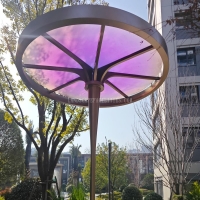Welcome to the website for landscape facilities products and knowledge.
How does the table’s surface texture affect writing, typing, or other work activities?
The texture of your desk surface plays a surprisingly crucial role in daily work activities, affecting everything from handwriting quality to typing speed and overall comfort. When writing with pen and paper, a slightly textured surface provides optimal resistance that improves pen control and reduces hand fatigue, while an overly smooth surface can cause pens to slip unexpectedly. For those who primarily type, the relationship becomes more complex - the texture beneath the keyboard matters less than the texture where wrists rest during extended typing sessions.
Smooth, polished surfaces like glass or high-gloss laminate may look aesthetically pleasing but often create practical challenges. These surfaces can cause papers to slide during writing, create distracting reflections under bright lighting, and accumulate visible fingerprints and smudges that require frequent cleaning. Conversely, moderately textured surfaces such as natural wood grain or manufactured micro-textures provide just enough friction to keep papers stationary while offering visual interest that reduces eye strain from prolonged screen exposure.
The material composition significantly determines these textural properties. Solid wood desks offer natural variations in texture that many find visually warm and physically comfortable. Engineered wood products like MDF often feature consistent, manufactured textures that provide reliable performance across the entire surface. Metal desks typically present smoother surfaces that work well in industrial settings but may benefit from desk pads for extended computer work. Glass surfaces, while modern in appearance, present the greatest challenges for both writing and typing due to their hard, unyielding nature.
Ergonomics research reveals that surface texture indirectly influences posture and comfort. A surface that's too abrasive can cause discomfort when resting arms during typing, while one that's too slick may promote excessive pressure as users subconsciously try to stabilize their movements. The ideal texture strikes a balance - providing enough friction to prevent slippage without creating drag that increases muscular effort. This balance becomes particularly important for tasks requiring precision, such as drafting or detailed artwork.
Environmental factors interact with surface texture in meaningful ways. In humid conditions, smoother surfaces may become slightly tacky, while very porous textures might absorb moisture and feel different. Temperature also affects perception - smooth, non-porous surfaces often feel cooler to the touch, while textured wood maintains a more neutral temperature. These subtle environmental interactions can unconsciously influence how comfortable we feel at our workstations throughout the day.
For those seeking to optimize their workspace, understanding these textural influences allows for better decision-making. Adding a quality desk pad can transform an otherwise problematic surface into an ideal working texture. Choosing desks with matte finishes rather than high-gloss surfaces reduces glare and visual fatigue. Even simple awareness of how surface texture affects your specific work habits can lead to adjustments that improve both comfort and output quality across various tasks from handwritten notes to extended typing sessions.
Related search:

Recommendation
Metal frame with gradient color acrylic combined with high-end shading landscape facilities